You'll find that canvas's relationship with water isn't as straightforward as it might seem. While this durable fabric offers natural water resistance, it's not inherently waterproof - a distinction that can greatly influence its performance in wet conditions. Understanding canvas's properties, limitations, and potential treatments becomes essential when you're selecting materials for outdoor applications or projects that require moisture protection. Let's examine what makes canvas water-resistant and how you can enhance its protective qualities.
Key Takeaways
- Canvas is naturally water-resistant but not waterproof, as its cotton fibers can absorb up to 27 times their weight in water.
- Untreated canvas allows water penetration over time, leading to swelling, shrinkage, and potential structural weakening of the fabric.
- Waterproofing treatments like wax, silicone sprays, or fluoropolymer coatings can enhance canvas's water resistance and durability
- Prolonged exposure to moisture can cause mildew growth and fabric deterioration if canvas isn't properly treated or maintained.
- Regular maintenance, including waterproofing reapplication and proper cleaning, is essential for maintaining canvas's water-resistant properties.
Is Canvas Waterproof?
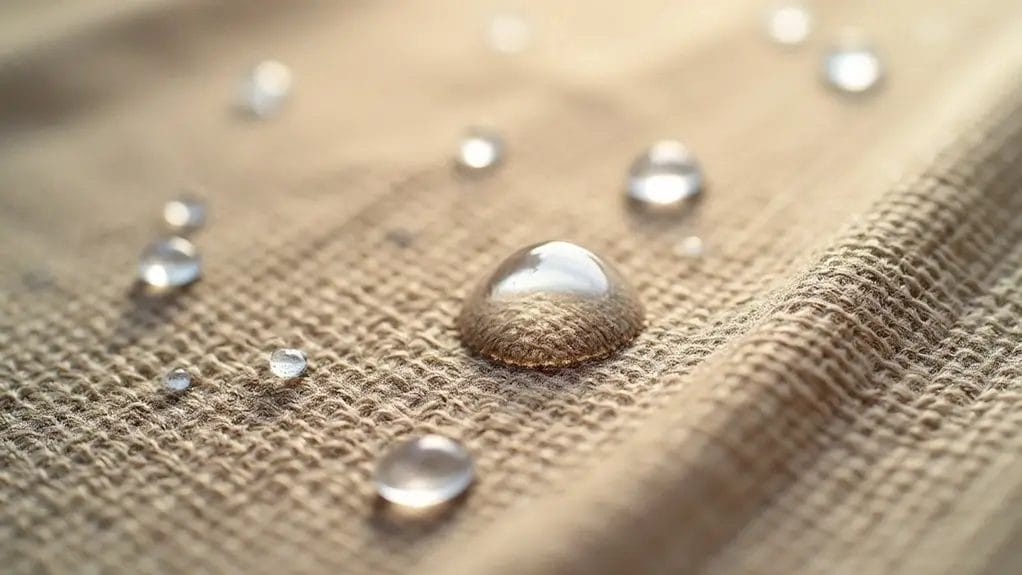
When you examine canvas fabric closely, you'll find it's naturally water-resistant rather than waterproof, thanks to its tight weave of cotton or synthetic fibers.
Many people incorrectly assume that all canvas is waterproof, but untreated canvas will eventually allow water to penetrate through its fibers.
While canvas can be made highly water-resistant through various treatments and coatings, true waterproofing requires additional processing with specialized sealants or waxes.
Understanding Canvas Fabric
Canvas is a durable plain-woven fabric traditionally made from cotton, linen, or hemp fibers. You'll find this textile characterized by its distinctive weave pattern, where heavy-duty yarns interlace in a simple over-under configuration.
The tightly woven structure creates a sturdy material that's both strong and versatile.
Common types of canvas include duck canvas, cotton canvas, and artist canvas, each varying in weight and fiber density. The material's strength comes from its thread count and the quality of fibers used.
Modern canvas can also incorporate synthetic materials like polyester, though traditional cotton remains the standard for premium applications.
Common Misconceptions About Canvas Waterproofing
Despite its robust construction, many people incorrectly assume that all canvas is naturally waterproof. The reality is that while canvas material offers some inherent water resistance, it's not fully waterproof without treatment. The tightly woven fibers provide initial water resistance, but untreated canvas will still absorb moisture over time.
- Canvas becomes less water-resistant as its protective coatings wear down through use and exposure.
- Natural canvas fibers can swell when wet, potentially leading to shrinkage and warping.
- Even treated canvas requires regular maintenance to maintain its water-resistant properties.
Understanding these limitations helps you make informed decisions about canvas applications where water protection is essential.
Why Natural Canvas is Not Waterproof?
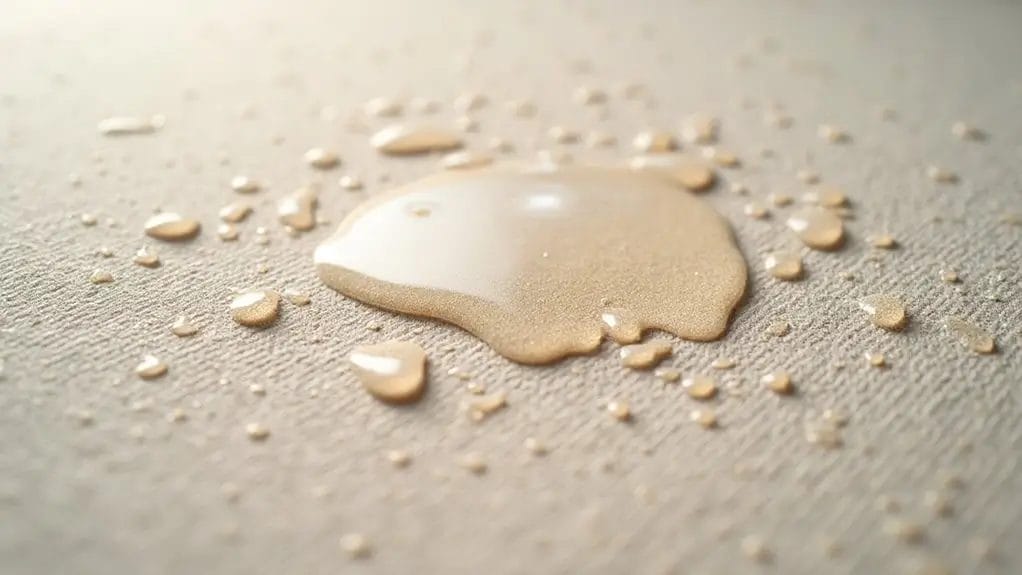
When you examine natural canvas, you'll find it's made primarily of cotton fibers that inherently attract and absorb water molecules due to their hydrophilic properties.
The typical plain weave structure of canvas, while dense and durable, still contains microscopic spaces between the yarns that allow water to penetrate and saturate the fabric.
Once water infiltrates the cotton fibers and weave structure, the canvas material swells and becomes heavier, demonstrating why it can't achieve true waterproof status without additional treatment.
Absorption Properties of Cotton
Natural cotton fibers, which make up untreated canvas material, have a strong affinity for water molecules due to their hydrophilic chemical structure. When you expose canvas fabric to moisture, the cotton fibers readily absorb and soak up water, making the material susceptible to water damage without proper protection.
- Cotton's molecular structure contains hydroxyl groups that actively attract and bond with water molecules
- Untreated canvas can absorb up to 27 times its weight in water without additional wax or coating
- The natural absorption process causes fibers to swell, reducing the fabric's dimensional stability
This inherent characteristic greatly impacts canvas's water resistance, making waterproofing treatments essential for outdoor applications.
Weave Structure and Its Impact on Water Resistance
Although canvas fabric's tight weave structure creates a dense material, its interwoven cotton yarns still form microscopic spaces between the threads that allow water molecules to penetrate.
The tightly woven warp and weft yarns contribute to canvas's durability but don't guarantee waterproof properties. When water contacts untreated canvas, it seeps through these tiny gaps between fibers.
You'll find that canvas made with this traditional weave structure requires additional waterproof coating to repel water effectively.
A protective layer helps seal these microscopic spaces while maintaining the fabric's natural durability. Without this treatment, the weave pattern alone can't prevent water absorption.
Effects of Wet Conditions on Natural Canvas
Despite its robust construction, untreated canvas fabric rapidly absorbs moisture due to cotton's hydrophilic properties.
When exposed to wet conditions, natural canvas materials like cotton and linen undergo significant physical changes that compromise their structural integrity.
- Your untreated canvas will swell and contract with humidity fluctuations, weakening fiber bonds and reducing durability.
- Rain exposure causes canvas fibers to become saturated, increasing weight by up to 50% and stretching the material.
- Prolonged moisture exposure leads to mildew growth and fabric deterioration, permanently damaging the natural materials.
These responses to wet conditions explain why untreated canvas isn't naturally waterproof and requires protective treatments for water resistance.
How to Make Canvas Waterproof
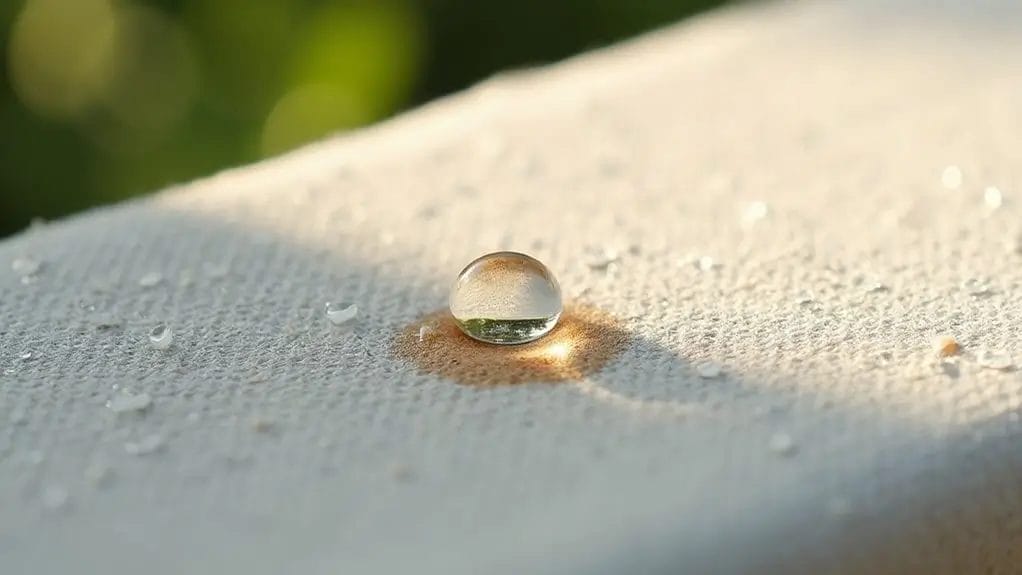
You'll find that transforming regular canvas into a water-resistant material requires applying specialized waterproofing treatments and coatings designed for natural fibers.
Waxing methods, particularly using beeswax or paraffin-based compounds, can greatly enhance the fabric's water resistance by creating a hydrophobic barrier on the fibers.
When selecting canvas materials for waterproofing projects, you should prioritize tightly woven varieties with higher thread counts, as these provide an ideal base for treatment absorption and long-term water resistance.
Waterproofing Treatments and Coatings
Several effective waterproofing treatments and coatings can transform standard canvas into a water-resistant barrier. Before you apply any chemical treatment, clean your canvas thoroughly to guarantee proper adhesion. Your chosen waterproofing treatment creates a protective layer that shields against exposure to moisture.
- Silicone-based sprays provide quick application and excellent water repellency
- Fluoropolymer coatings offer superior durability and long-lasting protection
- Wax-based treatments maintain the fabric's natural feel while adding water resistance
To maximize effectiveness, maintain regular reapplication schedules based on usage and environmental conditions. Different coatings suit specific purposes, so select treatments aligned with your canvas application requirements.
Enhancing Water Resistance through Waxing
Among traditional waterproofing methods, waxing stands out as a time-tested technique for enhancing canvas water resistance.
You'll need to apply paraffin or beeswax using controlled heat to penetrate the fabric fibers. This DIY process creates a protective barrier that repels water while allowing the canvas to maintain its breathability.
To preserve your outdoor canvas items, you'll want to enhance their durability through proper waxing care.
Apply the wax evenly in thin layers, ensuring complete coverage of the fabric surface. The heat treatment helps the wax bond with the fibers, creating a waterproof seal that withstands rain and moisture.
Choosing Water-Resistant Canvas Materials
When selecting canvas for water-resistant applications, the fiber composition and weave density play important roles in determining the fabric's natural water repellency.
The cloth's ability to withstand environmental impact depends on the specific properties of the materials used.
- Choose tightly-woven synthetic canvas with high thread counts to maximize water-resistant properties.
- Look for fabric treated with eco-friendly waterproof coatings that repel moisture while minimizing environmental impact.
- Select marine-grade canvas materials specifically engineered for outdoor gear and harsh weather conditions.
Consider both natural and synthetic options, evaluating their performance characteristics against your specific needs for waterproofing and durability.
Maintaining Waterproof Canvas
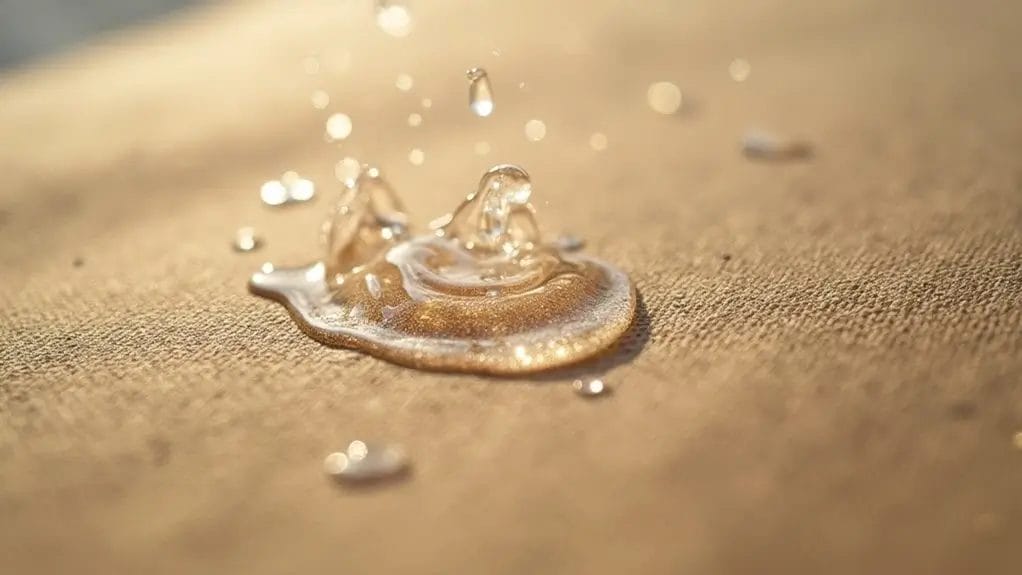
To maintain your waterproof canvas, you'll need to implement regular cleaning procedures using specialized fabric detergents and soft-bristled brushes to remove dirt, debris, and environmental contaminants.
Your cleaning routine should include thorough rinsing to prevent soap residue buildup, which can compromise the fabric's water-resistant properties.
For outdoor canvas applications, you'll want to perform periodic inspections of seams and high-stress areas, re-apply waterproofing treatments as needed, and guarantee proper ventilation during storage to prevent mold growth.
Cleaning Techniques for Canvas Fabric
Since maintaining waterproof canvas requires specific cleaning methods, it's essential to follow proper techniques that won't compromise the fabric's water-resistant properties.
You'll need to clean your canvas using a synthetic detergent specifically designed for waterproof materials. Avoid naturally harsh cleaners that can damage the protective coating.
- Use a soft brush to dry clean surface dirt, as rough scrubbing can wear down water resistance.
- Apply brand-specific canvas cleaner in gentle circular motions, avoiding excessive saturation.
- Consider alternative cleaning methods like spot treatment for stubborn stains to maintain fabric integrity.
Care Tips for Outdoor Use
Maintaining waterproof canvas in outdoor conditions requires three essential care practices: proper storage, UV protection, and regular waterproofing maintenance.
When using canvas outdoors, protect your tent, tarp, or cover from prolonged exposure to harsh elements.
Store your canvas bag or gear in a dry, ventilated space when not in use.
Apply UV-protective sprays to prevent sun damage and fiber breakdown of this heavy-duty fabric.
Reapply waterproofing treatments every 6-12 months, depending on usage frequency.
Between uses, brush off debris and guarantee the canvas is completely dry before storage to prevent mold growth and material deterioration.
Frequently Asked Questions
Can Canvas Fabric Be Used for Outdoor Furniture Cushions?
You can use canvas for outdoor cushions, but you'll need marine-grade or treated canvas with water-repellent finishes. It's durable and resists UV damage, though you'll want weatherproof backing for complete protection.
Does Waterproofing Canvas Affect Its Breathability and Comfort?
You'll notice reduced breathability when waterproofing canvas, as the treatment creates a moisture barrier that blocks both water penetration and air flow, potentially affecting the fabric's natural ventilation and comfort level.
How Long Does Waterproof Treatment Typically Last on Canvas Material?
You'll need to reapply waterproof treatment every 6-12 months, depending on usage and exposure. Heavy rain, UV rays, and frequent use will degrade the coating's effectiveness more rapidly.
Is Waterproofed Canvas Safe to Machine Wash?
You shouldn't machine wash waterproofed canvas, as agitation can damage the protective coating. Instead, spot clean with mild soap and water, or hand wash gently to preserve the waterproof treatment's integrity.
What's the Difference Between Water-Resistant and Waterproof Canvas?
Water-resistant canvas will repel light moisture but eventually soak through, while waterproof canvas has been treated with specialized coatings or waxes to completely block water from penetrating the fabric's fibers.
Conclusion
While you'll find that canvas offers inherent water resistance, it's not naturally waterproof. You'll need to apply specialized waterproofing treatments to protect your canvas materials from moisture absorption and deterioration. Regular maintenance of treated canvas surfaces, combined with proper storage practices, will guarantee ideal water resistance. Understanding canvas's material limitations and implementing appropriate protective measures remains vital for maximizing its performance in wet conditions.

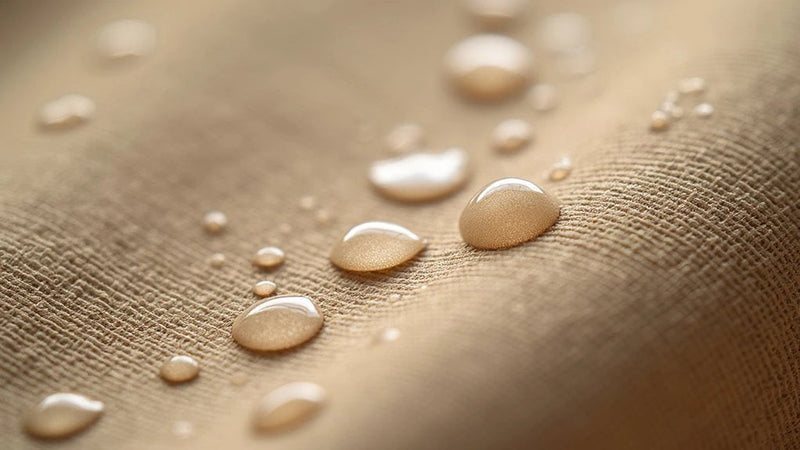
0 comments